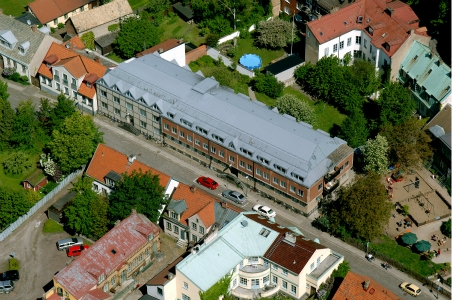The AF Bostäder foundation is an independent company with strong links with the student organization, Akademiska Föreningen (the Academic Society) in Lund. At present, we own and manage about 6000 student-adapted housing in central Lund, and are therefore southern Sweden's largest student housing company. But, let's go back about 190 years to see how it all started.
190 years in the service of students
Akademiska Föreningen was established in Lund at the start of 1830. It was not, as you might think, founded to look after students' interests, but more a case of keeping a check on them.
The students of that time had less money than today's, and also had an inclination for unsuitable pranks – pranks that can in no way be compared with today's harmless high-spirited activities. Students had problems living in harmony with the rest of the community, which can perhaps be attributed to their low average age and perhaps to the fact that most of them were men. Students were admitted to the university as early as age 15-16 and left the security of home.
Professor C A Agardh, who later became bishop of Karlstad, was one of the initiators of AF. He was convinced that a solution was needed in order to keep students away from influences such as "...mixing with friends who lacked morals" and encourage them to devote their time to more "cultural" activities. Professor Agardh got his inspiration from the English college system, and it was decided that the society would organize food and lodgings for some 50 students.
Four unmarried teachers would live with the students and supervise them
The rest of the staff would be male and preferably be German or French. This was because the students needed training in foreign languages. Akademiska Föreningen acquired Sylwanska gården, which became the site of the "barracks".
Today, it is easy to understand that the arrangement was not that popular among the students. Therefore the students' clubs took over Akademiska Föreningen, bought Sylwanska gården - with support from Sweden's crown prince Oscar - and a form of living with student influence was born.
Akademiska Föreningen became a place where students gradually devoted their time to more peaceful activities than previously. The high-spirited student way of life with student reviews and festivities began to emerge.
Now we jump to the mid-1940s. The post-war years dramatically affected the housing situation. Students streamed back from emergency service duty, the number of graduating students rose, and at the same time Lund's housing market contracted. It was clear that a serious housing shortage was looming.
The various student organizations, AF, and some of the student clubs addressed the problem and tried to find new forms of accommodation. Initially, it was hard to create financially sustainable solutions, but the State and municipality soon became aware of the problem and created suitable sanctions. Housing construction began to increase.
Gradually AF’s residence section separated from the other activities and was called AF Bostäder
 AF Bostäder's first modern student accommodation, Tomegapsgården, came into use in 1952 and is still part of our range. The first minuted meeting is dated 1954.
AF Bostäder's first modern student accommodation, Tomegapsgården, came into use in 1952 and is still part of our range. The first minuted meeting is dated 1954.
To improve its ability to look after its interests, and run modern student residences more effectively, AF Bostäder was converted into an independent foundation in 1983. The business concept of the new association was to provide inexpensive, purpose-built residences primarily for members of Akademiska Föreningen and it remains so today.
6000 student housing in Lund
We have about 6000 student housing in Lund. Half of these are corridor rooms and the rest apartments with 1-4 rooms. We also have some commercial premises for service companies.
We might wonder, now, if Professor Agardh could have foreseen what he was starting back in 1830. Probably not. Today, we can guarantee that our tenants don’t have to live with teachers to keep an eye on them. We certainly do not set moral standards for our tenants.
Instead, we aim to safeguard a total living environment where students have space for study, creativity, and relationships. Where they can live in harmony with the environment and can feel secure. The accommodation has an important social function which is mirrored in study results. Our tenants should be able to enjoy their student days, which for many will be among the best days of their lives.